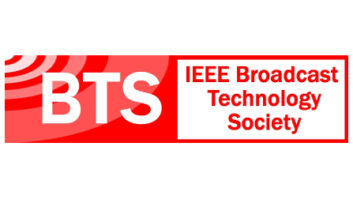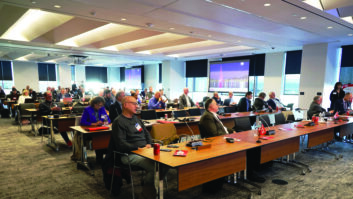WASHINGTON — Heftier tariffs on Chinese-made electronics and other products appeared to be on hold as of early December. But broadcast manufacturers, watching the business headlines, expressed concern over the long-term impact on hardware prices for radio industry buyers if and when higher tariffs do take effect.

A 10 percent levy on Chinese-made goods was announced earlier this summer and imposed in September. It was scheduled to ratchet up to 25 percent in the new year, but in December President Trump announced a 90-day hold that allowed for further negotiations between American and Chinese government officials, according to news reports. The proposed higher tariffs would have affected about 800 categories of goods and materials imported into the United States.
If negotiations fail to prevent an uptick, radio engineers may find their 2019 capital expenditure budgets stretched. Equipment manufacturers seem to be holding the line on equipment prices for now but noted the volatility of the situation.
SURCHARGES
Ben Barber, president and CEO of Inovonics Inc., said the company had received notification in June from several vendors that beginning in July there would be a surcharge added to invoices for certain components.
“Inovonics purchases the bulk of our raw components from U.S.-based companies like Arrow, Future, Digikey and Mouser, to name a few of the popular ones,” he said. “Now, of course, most all electronic components are manufactured offshore, but we do the major line of purchasing through these and other U.S. channels. Since July 2018, we have seen an increase in component prices, averaging somewhere around 19.5 percent.”
The potential price increase is “pretty nebulous” though, he continued. “For instance, we purchase OLED displays from a U.S.-based company that is adding $1.227 to each $20.45 display we purchase from them. When you buy in lots of 1,000 pieces, as we do, that surcharge increases our display costs by $1,227. That turns out to be an increase of 6 percent, which is a hard and fixed cost to Inovonics.”
The company manufactures audio processing, RDS messaging and signal monitoring gear. It received communications from U.S.-based distributors that on Jan. 1 they would add a 25-percent increase to component costs; Barber said this may be subject to change given the president’s subsequently proposed 90-day delay.
Adding to the complexity of this issue is that fact that supply chains are often convoluted and not always transparent, said Kris Bobo, managing director at Comrex. Components may be purchased from companies in the United States but still be subject to a tariff if they were originally from China.
“We’re currently discovering that any new tariff will have a much broader impact than we anticipated,” she said. “Almost all electronics contain parts that were originally manufactured in China. Even if something was built in another country, if it contains a component that originated in China, the price for American buyers will be affected in some way.”
Bobo said it isn’t possible to predict the impact of additional new costs because suppliers tend to handle them in different ways.
“It’s hard to predict how U.S. manufacturers can absorb such a substantial hit. We’re in the process of strategizing, but suffice to say, we’re concerned,” she said.
Comrex, which is based in Devens, Mass., produces a variety of audio and television codecs and studio telephone interfaces.
WAVE OF NOTICES
Ben Palmer, sales engineer with Arrakis Systems, said his company hadn’t been directly impacted yet by the tariffs on Chinese goods, but feels it’s likely that extra costs would eventually snake through the entire U.S. economy.
“We have received a wave of notices from our parts distributors that we would see an increase in cost on parts in the near future, but this hasn’t taken place yet. Most of our parts orders are placed and scheduled out for a year or more. This is useful when prices may bounce around, and for times like this,” Palmer said.
“Some of our parts distributors, such as Master Electronics, have made promises to not raise rates as a result of the tariffs. So we may see that some distributors may absorb some of the increases.”
Colorado-based Arrakis makes consoles, furniture and automation systems; it solders and assembles its hardware in-house and sources its fabricated metal from a local company, Palmer said, “the only exceptions being a small handful of components and ICs from companies such as Texas Instruments.”
Arrakis uses a parts management software program to track costs. “We evaluate the costs of our various assemblies on a regular basis. We are always focusing on keeping our product at the same competitive price point. As we see increases on prices for some components, we achieve the same costs by lowering our costs elsewhere.”
Manufacturer Wheatstone also is watching developments. “Components like NKK switches, raw PCBs, Amp connectors, AKM DACS and ADC, Panasonic and Nichicon capacitors, various LEDs and displays — there’s quite a list,” said Andy Calvanese, VP of technology and engineering for the company. “Many of these components are not available anywhere else and just about every manufacturer is affected as a result.”
Wheatstone, whose products include consoles, AoIP networking and audio processing gear, manufactures its products at its facility in New Bern, N.C., which helps the firm manage price fluctuations.
“Those companies that rely on third parties to assemble and manufacture for them are probably the most vulnerable to these kinds of price fluctuations … the more control you have over the process itself, the better off you are in terms of quality, pricing and delivery,” Calvanese said.
He said that a manufacturer’s inventory management may delay any impact. “We’re really aggressive about inventory, so realistically, broadcasters won’t see this tariff’s effects on Wheatstone products in the short term, given the way we manufacture and the inventory levels we carry,” he said. “Everyone will be affected by tariffs ultimately, unless the trade issues get resolved soon.”












